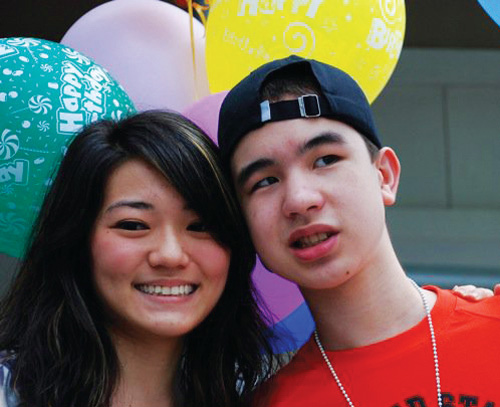Discovering what it takes to reach out to children with autism.
Contributed by Wayne Chan
 |
|
| PHOTO COURTESY OF JODY DOO | |
Loves hiding in corners, refusing to talk; pretty violent.
That was the mental impression that Jody Doo, 21, an aspiring actress and communications undergraduate, had of autistic children, before she met her student, Timmy Wicks, 14, whom she has been tutoring twice a week for two years. It was Timmy who helped Doo discover how mild and gentle an autistic child could be.
In today’s society, Doo is not alone in having misconceptions about autism. According to Santhi Singaram, 37, a program coordinator of RAYZ, a department of City Harvest Community Services Association that befriends and provides home therapy to the intellectually challenged, most people have extreme views when it comes to autism.
Having worked with people with special needs for 14 years, Singaram says that people perceive children with autism as either severely limited or extremely gifted.
The Kandang Kerbau Women and Children’s Hospital in Singapore detects about 200 cases of children with autism each year. And many children may have characteristics of Autism Spectrum Disorder. As the name implies, ASD is a condition that has a broad range of abnormalities. Hence not everyone who has ASD would display the same range of symptoms.
Singaram adds that the task of helping an individual with autism would seem frustrating for someone who may not fully understand the condition.
One of the common challenges is communication. In many cases of autism, the child in question may not be able to communicate his feelings clearly to his caregivers, who often have to second guess what their ward is trying to communicate to them.
Thankfully, these challenges did not stop Doo from taking on the job of tutoring Timmy. What started out for Doo as merely a job to earn extra income after her ‘A’ levels, soon grew to a love and an understanding for Timmy and his family.
“Having known Timmy for quite some time, I am able to predict how he’s going to respond. That’s when I’ll have to think of creative ways and methods to “outwit” him,” says Doo. “I motivate him with things that he likes, such as stickers, although these things could change from time to time, so I have to keep up.”
One of the tougher moments Doo faced with Timmy was when she had to discipline him for being too noisy by taking away his time with his computer. Although she found it difficult to do this when Timmy cried, Doo realized that being firm with Timmy would be better for him in the long run.
Singaram agrees that it is good to be consistent when handling an autistic child. Children with autism are not able to adapt to changes easily and can get distraught when faced with unfamiliarity or a change in routine; some deal with change by screaming, shouting, throwing things or even hitting themselves and others. Children with autism may also have sensory disorder which can cause them to be highly resistant to being touched; others display excessive force when holding on to objects or persons.
Hence, one can appreciate the challenge it takes for someone who is not trained, such as Doo, to reach out to an autistic child. Yet not only was Doo able to connect with Timmy, she has also built a firm friendship with Timmy’s parents, dropping by to visit the Wicks beyond her scheduled tuition hours.
Timmy’s mother, Susanna Wicks, affirms that Doo has been a great blessing to the family. “From the first time I met Jody, I knew she has a loving heart and genuinely wants to help Timmy,” says Wicks. “No amount of formal training can give one such intrinsic sense of motivation to want to make a difference to another person’s life, totally not driven by money but love and sincerity.
“Jody never talks down to him and expects him to give his best; which is also rare because many teachers would tend to expect less from the child … She’s a God-send.”
One of the biggest challenges faced by the Wicks was getting a local regular school to accept Timmy as a student who is capable of learning and living like others, albeit in his own way.
“Acceptance is tough and most times, the community feels that the less-able should be segregated instead of integrated,” says Wicks.
Singaram agrees that in spite of a greater awareness among the community regarding autism today, acceptance remains the biggest challenge. Inclusive practices are still lacking for people with autism to be integrated into the community. Ideally, more support and options should be available to care for children with autism.
As with the case of Doo, Singaram believes that untrained persons can help to fill this gap simply by befriending autistic children and teaching them basic daily living skills, such as taking the public transport, making purchases, or simply accompanying them on an outing and being affirming in unfamiliar situations.
For Doo, the biggest take-back she has received would be learning more about love, patience and acceptance through her relationship with Timmy. “I’ve found that children with autism are unique and adorable in their own ways,” she says. “Be open and after you get past your own personal barriers, you will grow to love them.”
For more information on autism, visit www.autism.org.sg; For more information on RAYZ, e-mail info@chcsa.org.sg.
